Artist Birthday: Homer Dodge Martin
In the mid- to late-1800s, there many American artists like Homer Dodge Martin who adapted the romantic element of Hudson River School painting, with the contemporary interest in misty atmosphere and light.
Artist Birthday for 28 October: Homer Dodge Martin (1836-1897 US)
 |
| Homer Dodge Martin, Effect of Trees, ca. 1879, oil on canvas, 20.5 x 25.6 cm © 2025 Brooklyn Museum image (BMA-901) |
While some scholars have labeled Martin's landscapes "Tonalist" and others "Impressionist", they are more likely closer to the Hudson River School aesthetic called Luminism. Luminism was a style in which the artist paid close attention to light and atmosphere, but not to the point of painting outdoors, like the Impressionists. This painting has all the earmarks of Luminism, on top of Martin's own peculiar vision of the Hudson River School credo. Starting in the 1870s, Martin's landscapes became less about places in New England, and more subjective visions of nature. Rather than approximating Impressionism in the lyrical lighting of this work, it more closely resembles the works of the more lyrical Realist painters of the 1850s and 1860s, particularly Corot's fuzzy trees and glowing atmosphere.
Background
There was virtually no tradition of landscape painting in American painting of the 1700s, save for overmantle decoration (a painted woodland scene above a fireplace, usually on the wall), and as backgrounds in portraits. In the early 1800s, after the Revolution (1783-1787), Americans, and Europeans alike came to appreciate the unique and spectacular nature of the American wilderness. Before 1825 in American painting, landscapes were rare, and lacked a thematic focus. The period after 1825 saw the flowering of the landscape as subject matter in American painting.
As Americans cleared the wilderness and tilled it for farms, constructed canals to increase commerce, and exploited the land for growing industrialization, Americans became nostalgic for what they knew they were slowly losing -- their unique wilderness. Authors and artists began to create romantic reminiscences of the American landscape before the Industrial Revolution.The movement, that is now called the Hudson River School, came to embody the ideals sought by Americans in views of their country. It is so named because many of the artists did landscapes up and down the length of the Hudson River in New York. It was these scenes that formed the kernel for the flowering of American landscape paintings. Many of these artists also did landscapes all over New England and New York. In the 1860s, the urge to present the grandeur and awesome beauty of the newly opened western territories led many of the Hudson River School artists to go to the West.
Homer Dodge Martin was born in Albany, NY. As a young person he worked as a carpenter and architect. He turned to painting in 1852 and was primarily self-taught. He moved to New York in 1862 and continued painting scenes of the Hudson River Valley, although, as he had done in the 1850s, he preferred scenes in the Adirondacks. He was particularly drawn to the work of Hudson River School painter John Frederick Kensett (1816-1872).
Martin made two European visits, first in 1876, and then in 1881 to 1886. The first visit, to France, was inspired by the works Camille Corot (1796-1875) and other painters of the Barbizon School that had just begun to be seen in New York. The Barbizon painters advocated painting out doors (which Martin never did), and emphasis on light, atmosphere and naturalism in landscapes. After returning to the US, Martin's work took on an even more light-filled quality than previously, and many of his late work, when his eyesight began to fail, verge on abstraction.
Martin became a member of the National Academy in 1874, and in 1877 helped found the Society of American Artists. After moving to Minnesota where he believed the crisp air would improve his health, Martin continued painting scenes of the Adirondacks, from memory.

Comments